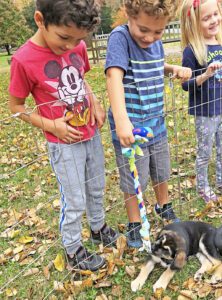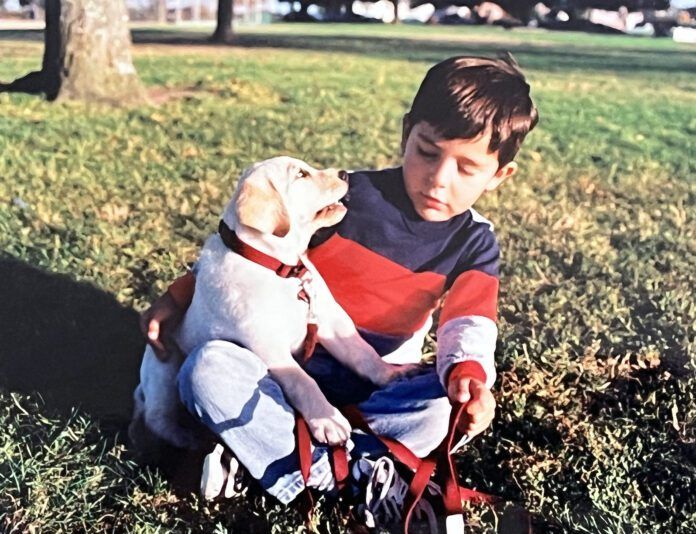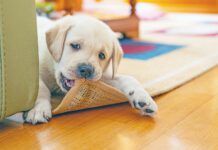Puppies use their mouths to interact with the world. They bite to play; they bite to investigate. They bite to ask; they bite to answer. They bite because they’re full of energy; they bite because they’re over-tired. They bite because they’re teething; and they bite when teething is supposedly over.
All of this biting is a very natural thing, developmentally speaking, on Planet Dog. Of course, it’s just as natural for us delicate-skinned folks on Planet Human to want it to stop, immediately! It’s awful when your puppy’s “attacking” everyone in the family. Then again, it’s also hard to be a misunderstood puppy transplanted out of your own culture.
The answer is to implement a plan that works for both sides of the teeth! Here’s a five-part plan for helping everyone make it peacefully through this challenging puppy phase:
- First, meet your puppy’s natural needs.
- Provide appropriate chew items.
- Use toys to occupy and fend off puppy teeth in play – and then, in games of tug, as a bridge tool to early training.
- Teach Planet Human ways (so-called “training”) gradually.
- Employ management equipment to keep everybody safe.
#1) Meet your puppy’s Planet Dog needs
I spend a giant percentage of my waking hours with puppies in their biting prime – between 3 weeks and 6 months of age. (This is because I specialize in puppyhood coaching, run a puppy socialization play-and-train group, and our family fosters litters of rescue puppies.) Quite often, exasperated owners drop their puppies off at my home, saying they can barely interact with their pup because of the nonstop biting. Hours later, when I send them videos of the puppy here – interacting with my human and dog family beautifully, with zero biting – they are simultaneously very hopeful and pretty annoyed.
What’s the secret? I jump into meeting the puppy’s basic Planet Dog needs before I try to interact in a human-oriented manner. Other than food and shelter, what are those needs? Think along the lines of:
- Socializing with their own kind.
- Digging, sniffing, foraging in nature.
- Running, chasing, and “hunting.”
- Exploring (and resting) at their own pace.
- Having mouthy fun like chewing sticks and biting friends.
At our house, a puppy gets to frolic – teeth and all – with fellow canines, sniff around in a yard bursting with interesting scents, dig in some dirt, chew some sticks, and maybe bark at a deer or a fox. When the puppy has had about half an hour of all that and wanders over to me, he’s no longer bursting with that wild I’ve-been-trapped-in-a-pen-in-the-living-room energy.
Mind you, it’s not that the puppy is exhausted after his half hour with us; he is simply filled up with appropriate enrichment experiences. He’s like a calmly alert second-grade boy who just had an awesome time at recess and is now actually able to sit down at his desk and listen.
No matter where or how you live, you can find a way to give your puppy daily doses of being a real dog. You’ll get the biggest bang for your buck by finding a puppy friend in your neighborhood for regular, delightfully bitey playdates. But an unrushed “sniffari” walking in an interesting spot, some interaction with nice adult dogs, and plenty of chances to chew or dig will help, too.
Meet those natural needs consistently, and the in-the-moment biting management strategies outlined next will do the rest. Every time you’re struggling to get them to work, ask yourself: “Did my puppy get to be a dog much today?” If the answer is no, start there.
#2) Provide ample and appropriate chew items
Sometimes, your puppy’s biting is simple – a demonstration of his biological need to chew. Chewing is a natural canine pastime, and for teething puppies it’s vital. Having great things on hand that prompt a satisfying, long chew session will pay off in a happier puppy who learns the great habit of chewing “legal” items.
But what’s safe to use? There are horror stories about rawhides that cause intestinal blockages, bully sticks that are a choking hazard, toys with threads that get swallowed and tangle intestines, and marrow bones that break off and puncture organs. In fact, there’s almost no chew item that’s completely safe. Just because it’s labeled for puppy use doesn’t mean it won’t land you in the ER!
However, back to this section’s main point: Puppies absolutely need to chew, and those dramatic medical crises are unlikely if you use appropriate chew items. That said, everybody has to make their own risk-assessment choices. Here are my own guidelines:
- Food-stuffed Kongs and Toppls (in the correct, non-swallowable sizes for each pup) are the safest choices. Put nutritious stuff in there (a mixture of a spoonful of canned food, some moistened kibble, some almost-too-old carrots or green beans, some plain yogurt, and a smear of peanut butter) so that you’ll feel comfortable using these every day. Freeze them so they last 20 minutes instead of five.
- For everything else, watch like a hawk at first while you’re learning your puppy’s chewing style. Later, always stay nearby with an ear open (for sounds of coughing or choking).
- As you evaluate different chewing styles, watch out for the pup who is shockingly fast and able to break off pieces of his chew items; he gets a smaller variety of allowed items.
- Keep in mind that the presence of another dog will often make a puppy chew too fast.
- Also at the root of a switch to dangerous, too-fast chewing is the approach of an owner saying in a threatening tone, “Hey, give that to me!” If you need to take something away, stay cheery, give no attention to the item, and make a little trail of treats (such as bits of ham or roasted chicken) in the other direction. As pup follows the fun new yummies, swipe the chew he left behind.
- Fresh marrow bones that the butcher cuts to about a 3-inch length are awesome. While adult dogs can break them into pointy parts, or crack their teeth on them, puppies don’t have the strength for that. I personally will leave a puppy unsupervised in a crate with a nice new marrow bone like this. If you want to make one last a few days, pop it back in the fridge after each 20-minute chewing session.
- Rawhides and bully sticks are famous for creating digestive upset, blockages, and choking problems. If I use them, I supervise 100% of the time. Also, I buy only giant sizes, because it’s the tiny ones marked “for puppies” that are much more likely to get swallowed or lodged in the pup’s throat or digestive tract, sheesh! I get the ones that are either super thick or super long, and I offer them to pups in 20-minute increments before the chews go back in the basket.
- If a puppy does chew an item down to a swallowable size, I throw it away well before it could become a choking hazard. (Given the price of bully sticks, that kills me, but that stomach surgery would be more!)
#3) Use toys to fend off puppy teeth, then play tug
With those sharp teeth and the clever disguise of extreme cuteness, it takes only a second for a puppy to draw blood or rip your pants. And believe it or not, the worst part of that isn’t the blood and the rip. It’s that your puppy got a chance to rehearse that bitey behavior. Chances are it felt fun and rewarding to her – “Yay! This feels like home, with my littermates!” – which means she’s more likely to repeat it.

Don’t let that happen. Instead, every single time you approach, reach into the overflowing toy basket you have handily placed right at the entrance to any place the puppy spends time. Grab a tug toy or two. At first, when the puppy is brand new to you, you’re just using those toys to fend off those needle-sharp puppy teeth.
How well the classic replace-hand-with-toy strategy works in decreasing painful bites depends on your ability to choose the right toys (by observing closely which ones are favorites for your particular pup) and keeping them in the right spots.
In the earliest fend-off stage, big stuffed animals that will block the mouth and protect your hand are a great choice. As you move into tug, you’ll likely find that long, flat, furry animals (bonus if there’s a squeaker in the tail) work best. As for rope toys, the thick, hard ones tend to be ignored while the stretchy, soft, braided fleece style is perfect. (You can make them yourself!)
Keep in mind that length is a hand-saver. Very skilled puppy wranglers can make good use of a six-inch tug toy, but newbies will find that the longer the toy, the safer the human. If you have young kids, you’ll be so grateful if you add that three-foot, crinkly snake to the repertoire.
Even if you have all the right toys for your pup, the way you store and manage them can make all the difference. I want you to have so many options you could litter the puppy’s floor with them. But should you? Nope! Because if that toy has been lying around for days, it won’t be very enticing.
If, instead, you select the fluffy, squeaky raccoon the puppy hasn’t seen since last Tuesday: Bingo! Teeth are engaged in a way that makes everybody happy. (Always rotate your toys. Keep just a few out for the morning, then swap them out for the afternoon, and again in the evening.)
Soon enough you’ll be using toys less as a shield and more as a tool for interaction, by encouraging your puppy to play a game of tug – a beautiful Planet Dog / Planet Human compromise. Tug allows us to give the puppy a YES in response to her innate impulse for physical, bitey play – instead of trying to shut her down with a NO that’s as ineffective as it is unfair.
Back in the alpha-obsessed dark ages of dog training, “experts” used to tell folks that playing tug would teach their dog to question their authority. The modern, happy reality is that tug can be a great opportunity to build cooperative communication, as you slowly start to add some structure to the game.
For example, you begin to teach that a polite sit re-starts the game, and you work toward teaching a “Drop” cue. The result? Fun plus learning plus communication plus bonding.
#4) Introduce fun training games

In calmer moments of the day, when your puppy is not all teeth, start introducing a fun new way to pass the time: training. By using tiny bits of food to teach and reward behaviors like “sit” and “touch,” you can open up a whole new way for the puppy to interact with another being. The more the puppy learns to love fun, food-filled training, the sooner you can use training as a way to redirect the biting. Rather than ignoring your voice and continuing an assault on your pant leg, the pup will begin to stop and think, “Oh, right. Let’s do that instead.” Win-win!
One of the best training games to play with a jumpy, bitey puppy is an energetic melding of the games “Find it!” and trainer/author Leslie McDevitt’s game, “Ping-pong.” Here’s how it works: Pup heads to you and you toss a treat very obviously on the floor, calling out the cue “Find it!” Pup will gobble the treat and then swivel back to you. As the eyes meet yours, say “Yes!” and toss a treat to the other side: “Find it!” Repeat, repeat, repeat as pup goes back and forth (like a ping-pong game).
Here are the advantages to this simple game:
- It rewards eye contact and focus on you (because that’s what re-starts the game), which is the giant first step in training.
- It’s an active game for the puppy (so it suits a jumpy/bitey mood) – and yet it’s controlled by you.
- It can be scaled up in terms of difficulty (throw farther), energy expended (add in a little jump over your legs that are extended on the floor), or behavior needed to re-start the game (move from eye contact, to a sit, to a sit-touch-spin).
If you greet your bitey pup with a short game of tug followed by a few minutes of this kind of training, you’ll have drained some energy and established an atmosphere of cooperation. Mental stimulation can be more tiring than plain old physical exertion, which is one reason this ping-pong game is better than an endless game of tug.
Mind you: This won’t work on Day One, because you haven’t yet built up the bond and the understanding that listening to you presents opportunities to earn yummy stuff. To review: The strategy for biting on Day One is fending off teeth with stuffed animals; followed a few days later by a more nuanced tug game; and only later by using a training session to deal with a bitey mood.
#5) Put management tools to work: pens, gates, and crates
Of course, sometimes none of these strategies work! (Remember, your first thought is: “Oh, wait, has my puppy had a chance to be a dog today?”) Even when you’re doing everything right, along comes the witching hour where nobody can be safely around the puppy. This is where the beauty of “management” shines. Hello pens, gates, and crates!
We all need to be able to pop that pup into a safe area where she can’t do any harm. To ease that moment of separation, toss a handful of kibble on the floor (“Find it!”) and/or use a chew. Use this option when:
- You truly do not have time this morning to give the pup the playdate or sniffari she really needs.
- You’ve been trying tug and/or training, but pup is still wildly going for your limbs.
- The combo of the kids’ mood and the puppy mood means disaster.
- Puppy is in a wild mood because of being over-tired and needs confinement to encourage that sleep.
Stick to a plan
When it’s all written out, this plan to get through puppy’s biting stage appears complex. Honestly, it’s really not once you’re in the swing of it! It’s just that many people don’t have a plan for dealing with this phase at all – puppy cuteness seems to fool people into thinking that it’s all going to be rainbows and butterflies! Keep these five steps top of mind and you’ve got the guidance you need to weather this adorable but prickly stage of your new puppy’s life.





